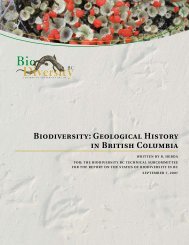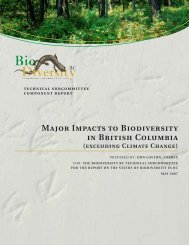Taking Nature's Pulse - Biodiversity BC
Taking Nature's Pulse - Biodiversity BC
Taking Nature's Pulse - Biodiversity BC
- No tags were found...
You also want an ePaper? Increase the reach of your titles
YUMPU automatically turns print PDFs into web optimized ePapers that Google loves.
TlingitTlingitHaidaHaidaTutchoneTutchoneTsimshianHeiltsukGeorgia Straits Region:A) ComoxB) SecheltC) SquamishD) HalkomelemE) Northern Straits SalishF) ClallamG) NooksackGeorgia Straits Region:A) ComoxB) SecheltC) SquamishD) HalkomelemE) Northern Straits SalishF) ClallamG) NooksackTagishTsimshianHeiltsukTagishPrince Rupert------------------TahltanInlandTlingítSekaniTahltanNat'ootenGitxsanHaislaNisga'aWet'suwet'enPrince RupertKwakwalaKwakwalaDitidahtNisga'aGitxsanSekaniHaislaOweekeno Tsilhqot'inWet'suwet'enNuxalkANuu-chah-nulthOweekenoNuu-chah-nulthDitidahtfigure 6: First Nationslanguages of BritishColumbia.InlandTlingítNuxalkFKaskaNat'ootenDakelhDakelhB Tsilhqot'inCFABKaskaStl'atl'imxVancouverDE GStl'atl'imxCVancouverDE GNlaka’pamuxNlaka’pamuxare approximate and subject to revision. NamesFirst Nationsused here are those which are preferred by FirstNations and have come into general acceptanceLanguages of Britishfor the languages concerned. They are alsosubject to revision. ColumbiaDunne-zaDene-thahDunne-za CreePrince GeorgeCreeSecwepemcPrince GeorgeKamloopsSecwepemcOkanaganFirst NationsLanguages of BritishColumbia taking nature’s pulse: the status of biodiversity in british columbiaKamloopsOkanagan© 1994 U<strong>BC</strong> Museum of AnthropologyThis map is regularly revised. Latest revision October 15, 1996.No reproduction without permission.Boundaries on this map mark out areas withinwhich distinct languages are spoken. The areas© 1994 U<strong>BC</strong> Museum of AnthropologyThis map is regularly revised. Latest revision October 15, 1996.No reproduction without permission.Dene-thahBoundaries on this map mark out areas withinwhich distinct languages are spoken. The areasare approximate and subject to revision. Namesused here are those which are preferred by FirstNations and have come into general acceptancefor the languages concerned. They are alsosubject to revision.KalispellKalispellKtunaxaKtunaxasource: U<strong>BC</strong> Museumof Anthropology.notes: This map is regularly revised. Latest revision October 15, 1996.No reproduction without permission.Boundaries on this map mark out areas within which district languages arespoken. The areas are approximate and subject to revision. Names used hereare those which are preferred by First Nations and have come into generalacceptance for the languages concerned. They are also subject to revision.and glue; kelp for fishing line and containers; shells, bone and antler for knives,chisels and points; and a host of other substances for dyes, stains, waterproofing,cleansing and protective scents. 34 A host of medicines for maintaining healthand treating injuries and ailments of many kinds have been derived from plants,35, 36, 37as well as some animals and fungi.Plants, animals and fungi are also prominent in First Nations’ belief systems,art, songs and ceremonies. 38,39 Ceremonial species and those featured in art andnarrative are often the same ones that have practical applications. 40 The richnessof Northwest Coast First Peoples’ connections with biodiversity is reflectedperhaps most famously in their world-renowned art forms, which representanimals, birds, fish and other beings in totem poles, masks, dishes, jewellery,sculptures and paintings. 41,42,43 These designs represent key figures in the historiesof families, clans and individuals. Their immense power and compelling formsymbolize the depth of human reliance on biodiversity.Food species alone include at least 100 animal species and 150 plant speciesacross the different nations and regions of the province. Species used for materialor technology number at least 100, and medicinal species probably 300 or more.Altogether, about 400 to 500 species (some used for more than one purpose) arenamed and used or have specific cultural importance for B.C.’s First Peoples.Many others – including many attractive wildflowers that might not be namedindividually, but are nonetheless recognized and distinguished – have generalimportance. First Nations’ knowledge systems encompass immense expertiseabout the ecological and morphological characteristics of plants and animals.Many species serve as indicators of traditional seasonal rounds, with the floweringof certain plants, the songs of certain birds or the appearance of certain typesof butterflies or other insects marking seasonal changes or signalling the time forimportant harvest events. 44Some plants and animals are so important and well known that First Peoplesrecognized and named different varieties and strains. For example, the Gitga’atof Hartley Bay have names for at least six different varieties of Pacific crab apple







